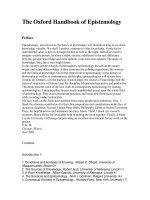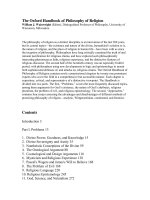Oxford handbook of health economics, the sherry glied, peter c smith
Bạn đang xem bản rút gọn của tài liệu. Xem và tải ngay bản đầy đủ của tài liệu tại đây (10.34 MB, 1,221 trang )
THE OXFORD HANDBOOK OF
HEALTH ECONOMICS
THE OXFORD HANDBOOK OF
HEALTH ECONOMICS
Edited by
SHERRY GLIED
and
PETER C. SMITH
Great Clarendon Street, Oxford, OX2 6DP,
United Kingdom
Oxford University Press is a department of the University of Oxford. It furthers the University’s
objective of excellence in research, scholarship, and education by publishing worldwide. Oxford is a
registered trade mark of Oxford University Press in the UK and in certain other countries
© Oxford University Press 2011
The moral rights of the authors have been asserted
First published in 2011
First published in paperback 2013
Impression: 1
All rights reserved. No part of this publication may be reproduced, stored in a retrieval system, or
transmitted, in any form or by any means, without the prior permission in writing of Oxford University
Press, or as expressly permitted by law, by licence or under terms agreed with the appropriate
reprographics rights organization. Enquiries concerning reproduction outside the scope of the above
should be sent to the Rights Department, Oxford University Press, at the address above
You must not circulate this work in any other form and you must impose this same condition on any
acquirer
British Library Cataloguing in Publication Data
Data available
Library of Congress Cataloging in Publication Data
Data available
ISBN 978–0–19–923882–8 (hbk)
ISBN 978–0–19–967540–1 (pbk)
Printed in Great Britain
on acid-free paper by
Ashford Colour Press Ltd, Gosport, Hampshire
Links to third party websites are provided by Oxford in good faith and for information only. Oxford
disclaims any responsibility for the materials contained in any third party website referenced in this
work.
ACKNOWLEDGEMENTS
THE editors would like to thank all those who contributed their expertise to this volume. At Oxford
University Press, the handbook was commissioned by Sarah Caro, who guided the early development
of the volume, and brought to a successful conclusion by Georgia Pinteau. We also greatly
appreciated the help of the publisher’s editorial team, which included Chris Champion, Emma
Lambert, Rachel Platt, and Aimee Wright. Great thanks are due to Vanessa Windass, who provided
unfailing secretarial support throughout the project, and to Dahlia Rivera. Finally, we should like to
thank the authors, whose scholarship is evident throughout these pages, and who responded to
editorial suggestions with great wisdom and patience.
CONTENTS
List of Figures
List of Tables
List of Boxes
List of Contributors
1. Introduction
SHERRY GLIED AND PETER C. SMITH
2. Health Systems in Industrialized Countries
BIANCA K. FROGNER, PETER S. HUSSEY, AND GERARD F. ANDERSON
3. Health Systems in Low- and Middle-income Countries
ANNE MILLS
4. The Political Economy of Health Care
CAROLYN HUGHES TUOHY AND SHERRY GLIED
5. The Promise of Health: Evidence of the Impact of Health on Income and Well-Being
WILLIAM JACK
6. Health Production
KRISTIAN BOLIN
7. Socioeconomic Status and Health: Dimensions and Mechanisms
DAVID M. CUTLER, ADRIANA LLERAS-MUNEY, AND TOM VOGL
8. Determinants of Health in Childhood
MICHAEL BAKER AND MARK STABILE
9. Economics of Infectious Diseases
RAMANAN LAXMINARAYAN AND ANUP MALANI
10. Economics of Health Behaviors and Addictions: Contemporary Issues and Policy Implications
DONALD S. KENKEL AND JODY SINDELAR
11. Economics and Mental Health: An International Perspective
RICHARD G. FRANK
12. Public-Sector Health Care Financing
ÅKE
BLOMQVIST
13. Voluntary Private Health Insurance
PETER ZWEIFEL
14. Health Care Cost Growth
MICHAEL E. CHERNEW AND DUSTIN MAY
15. User Charges
ERIK SCHOKKAERT AND CARINE VAN DE VOORDE
16. Insurance and the Demand for Medical Care
MARK V. PAULY
17. Guaranteed Access to Affordable Coverage in Individual Health Insurance Markets
WYNAND P. M. M. VAN DE VEN AND FREDERIK T. SCHUT
18. Managed Care
LAURENCE BAKER
19. Hospitals: Teaming Up
PEDRO PITA BARROS AND PAU OLIVELLA
20. Primary Care
ANTHONY SCOTT AND STEPHEN JAN
21. The Global Health Workforce
TILL BÄRNIGHAUSEN AND DAVID E. BLOOM
22. The Economics of the Biopharmaceutical Industry
PATRICIA M. DANZON
23. Disease Prevention, Health Care, and Economics
JANE HALL
24. Long-term Care
JOSE-LUIS FERNANDEZ, JULIEN FORDER, AND MARTIN KNAPP
25. Physician Agency and Payment for Primary Medical Care
THOMAS G. MCGUIRE
26. Provider Payment and Incentives
JON B. CHRISTIANSON AND DOUGLAS CONRAD
27. Non-price Rationing and Waiting Times
TOR IVERSEN AND LUIGI SICILIANI
28. Increasing Competition Between Providers in Health Care Markets: The Economic Evidence
CAROL PROPPER AND GEORGE LECKIE
29. Measuring Organizational Performance
JAMES F. BURGESS JR. AND ANDREW STREET
30. Health System Productivity
JACK E. TRIPLETT
31. The Methods of Cost-effectiveness Analysis to Inform Decisions about the Use of Health Care
Interventions and Programs
SIMON WALKER, MARK SCULPHER, AND MIKE DRUMMOND
32. Analyzing Uncertainty in Cost-effectiveness for Decision-making
SUSAN GRIFFIN AND KARL CLAXTON
33. Health Utility Measurement
DONNA ROWEN AND JOHN BRAZIER
34. Concepts of Equity and Fairness in Health and Health Care
JAN ABEL OLSEN
35. Measuring Inequality and Inequity in Health and Health Care
EDDY VAN DOORSLAER AND TOM VAN OURTI
36. Inter-generational Aspects of Health Care
LOUISE SHEINER
37. Econometric Evaluation of Health Policies
ANDREW M. JONES AND NIGEL RICE
38. Health Economics and Policy: The Challenges of Proselytizing
ALAN MAYNARD AND KAREN BLOOR
Index
LIST OF F IGURES
2.1 Health care sector share of total health care spending in the median OECD country, 1970–2005
2.2 Decomposition of average annual growth in health spending into growth in GDP, aging, and
excess in OECD countries, 1970–2005
3.1 The health system
3.2 Out-of-pocket share of total health expenditure in relation to GDP per capita
3.3 Median coverage levels for priority maternal, neonatal, and child health interventions (68
priority countries)
3.4 Use of public and private services
3.5 Volatility of external funding
3.6 External funding for maternal and neonatal health in relation to need
4.1 Government health expenditures as a share of all health expenditures and as a share of all
government outlays, 2005
5.1 Life expectancy per capital GDP (US dollars)
6.1 Illustration of the productivity of health capital
6.2 Illustration of the demand for health capital
6.3 Illustration of the effect of age on the demanded amount of health capital
6.4 Illustration of the effect of a wage rate increase
6.5 Illustration of the effect of an increase in educational capital on the demanded amount of health
capital
7.1 Education and mortality among adults over 40, US and Europe
7.2a Education and mortality, US adults over 25
7.2b Education and self-reported health, US adults over 25
7.3a Income and mortality, US adults over 25
7.3b Income and self-reported health, US adults over 25
7.4 Occupation and mortality, US adults ages 25–65
7.5a Race and mortality, US adults over 25
7.5b Race and self-reported health, US adults over 25
11.1 Managed care rationing by shadow prices
11.2 Budgets and incentives for public mental health services
13.1 Optimal wealth levels depending on the state of health
14.1 Cost growth in OECD countries
14.2 Total health expenditures as a share of gross domestic product, 1960–2004
15.1 Optimality of user charges as a revenue-raising device
17.1 Three modalities of organizing the payment flows of a subsidy system
18.1 Characteristics of 4 stereotypical types of health insurance plans
21.1 Quotients of urban nurse-to-population ratios divided by rural nurse-to-population ratios
21.2 Quotients of urban physician-to-population ratios divided by rural physician-to-population
ratios
21.3 Estimates of health worker emigration rates in sub-Saharan African countries, 2004
24.1 Projected changes in employment (% change of employed people aged 15–64 between 2003
and 2050), EU 25
24.2 Changes in the targeting of community care services for older people by sector of provision,
1993–2008
25.1 Physician preferences and choice of treatment in mixed payment systems
26.1a Panel A—marginal revenue (MR), marginal cost (MC) of quantity
26.1b Panel B—marginal revenue (MR), marginal cost (MC) of quality
29.1 Production frontier: data envelopment analysis
29.2 Production frontier: stochastic frontier analysis
31.1 Assessing the cost-effectiveness of an intervention given an objective of maximizing health
subject to a fixed budget
31.2 The incremental cost-effectiveness plane
31.3 Top right quadrant of the cost-effectiveness plane for options Z, W, and Y as defined in Tables
31.1 and 31.2
32.1 Incremental cost-effectiveness plane
32.2 Cost-effectiveness acceptability curves for three mutually exclusive interventions
32.3 Cost-effectiveness acceptability frontier and population EVPI for three mutually exclusive
alternatives
33.1 Standard gamble for a chronic health state valued as better than dead
33.2 Time trade-off for a chronic health state valued as better than dead
33.3 Visual analog scale
33.4 Observed and predicted EQ-5D scores using a variety of models mapping the SF-36 and SF12 onto EQ-5D
33.5 Time trade-off for a chronic health state valued as worse than dead
33.6 Predicted EQ-5D health state utility values using the standard and episodic RUM model
33.7 “Lead time” time trade-off for a health state valued as better than dead
33.8 “Lead time” time trade-off for a health state valued as worse than dead
34.1 The determinants of ill health
34.2 Equality, efficiency, and trade-offs
34.3 A more general health frontier
35.1 Two hypothetical concentration curves
35.2 Horizontal inequity indices for probability of a specialist visit, by country (with 95%
confidence interval)
35.3 Decomposition of inequity in the probability of a specialist visit (excluding need
contributions)
35.4 Short-run (SR) versus long-run (LR) “conservative” inequity for number of GP visits, by
country
35.5 Short-run (SR) versus long-run (LR) “conservative” inequity for number of specialist visits, by
country
36.1 Health spending by age group, US, 2004
36.2 Distribution of spending by age in Canada
36.3 Ratio of elderly to non-elderly health spending, Japan
36.4 Distribution of US health spending by age group
36.5 Net benefits from Medicare, by cohort
37.1 A simple example of potential outcomes
38.1 Williams’ plumbing diagram
LIST OF TABLES
2.1
2.2
2.3
2.4
Health Care Spending in OECD Countries, 2008
Percent Change in Health Spending and GDP, 1970–2008
Number of CT Scanners and MRI Units per Million Persons, 2008
Percentage Change in Mortality per 100,000 Capita for Five Common Chronic Diseases,
1970–2007
3.1 Selected Health Indicators and GDP Per Capita
3.2 Health System Financing
3.3 Health System Inputs
3.4 Inequalities Within Country Groupings
3.5 The Impact of Weak Information Systems
7.1 Socioeconomic Status and Health, NHIS 1990, Ages 25–64
11.1 Spending on Health and Mental Health as Share of GDP
11.2 Psychiatric Beds per 100,000 Population
15.1 Out-of-Pocket Payments in Different Regions of the World
15.2 Countries with Out-of-Pocket Expenditures >60 Percent of Total Health Expenditures in 2005
17.1 Effectiveness and Market Distortions of Different Strategies to Make Individual Health
Insurance Affordable for High Risks in a Competitive Insurance Market with Open Enrollment
17.2 Criteria to Compare Three Modalities (see Figure 17.1) of Organizing the Payment Flows of
Risk-Adjusted Subsidies
21.1 Estimates of Stocks of Physicians who Emigrated from Selected Sub-Saharan African
Countries
31.1 Costs and QALYs of Mutually Exclusive Alternatives
31.2 Incremental Costs and QALYs of Mutually Exclusive Alternatives
32.1 Uncertainty in Population Net Health Benefits
32.2 Uncertainty in Net Health Benefits
33.1 Classification Systems of Generic Preference-Based Measures of Health
33.2 Valuation Methods of Generic Preference-Based Measures of Health
34.1 Differences in Health Streams Across Patients (Figures in Terms of QALY)
35.1 Changes in Inequality With and Without Integrated Management of Childhood Illness (IMCI) in
Rural Tanzania
36.1 Age Distribution of Health Spending, United States, 2004
36.2 Age Distribution of Health Spending Across Countries
36.3 Internal Rates of Return to Medicare
38.1 Percentage of Articles Falling in Each of Williams’ Categories in the Two Leading Health
Economics Journals up to 2000
38.2 Contributions from this Volume to Each of Williams’ Categories
LIST OF B OXES
17.1 Reasons Why Risk-adjusted Subsidies may be Insufficient to Guarantee Affordable Coverage
for all High-Risk Individuals, at Least in the Short Run
17.2 Limitations of Guaranteed Renewability
17.3 Unfavorable Effects of Risk Selection
17.4 Risk Equalization: Risk-adjusted Compensations to Insurers
17.5 Risk Equalization in the Netherlands, 2009
31.1 A Clinical Scenario to Illustrate the Methods of Economic Evaluation: Introduction
31.2 Quality-adjusted Life-years from an Intervention
31.3 Deriving Health-related Quality of Life Weights
31.4 EuroQoL (EQ)-5D
31.5 A Clinical Scenario to Illustrate the Methods of Economic Evaluation: Measuring and Valuing
Outcomes
31.6. Examples of Revealed Preference and Contingent Valuation
31.7 A Clinical Scenario to Illustrate the Methods of Economic Evaluation: Dealing With Costs
31.8 A Clinical Scenario to Illustrate the Methods of Economic Evaluation: Decision Rules
32.1 Cost-Effectiveness Analysis
32.2 Clinical Scenario: Introduction
32.3 Clinical Scenario: Searching and Synthesis
32.4 Clinical Scenario: Probabilistic Sensitivity Analysis
32.5 Clinical Scenario: Approval, Delay, or Coverage with Evidence
LIST OF CONTRIBUTORS
Gerard F. Anderson, Ph.D., is a professor of health policy and management, professor of
international health, and professor of medicine at Johns Hopkins University. Dr. Anderson is
currently conducting research on chronic conditions, comparative health care systems, health care
payment reform, and technology diffusion. He has authored two books, published over 200 peerreviewed articles, testified in Congress over forty times as an individual witness, and serves on
multiple editorial committees. Prior to his arrival at Johns Hopkins, Dr. Anderson held various
positions in the Office of the Secretary, US Department of Health and Human Services.
Laurence Baker is Professor of Health Research and Policy at Stanford University, and Research
Associate of the National Bureau of Economic Research. His research includes extensive analysis of
managed care and its effects on health care delivery, costs, and outcomes. He received his Ph. D. in
Economics from Princeton University in 1994.
Michael Baker is a professor of economics and public policy at the University of Toronto and a
research associate of the NBER. His recent research focuses on how public policies affect mothers’
decisions to return to work after giving birth, and thereby their children’s health and development.
Till Bärnighausen is Assistant Professor of Global Health at the Harvard School of Public Health
and Senior Epidemiologist at the Africa Centre for Health and Population Studies, University of
KwaZulu-Natal. He has published widely on health systems in developing countries, HIV
epidemiology, and HIV services, systems and economics. Till is a medical specialist in Family
Medicine. He holds doctoral degrees in International Health Economics (Harvard) and History of
Medicine (Heidelberg), and master degrees in Financial Economics (SOAS) and Health Systems
Management (LSH&TM).
Pedro Pita Barros is Professor of Economics at Universidade Nova de Lisboa. His research focuses
on health economics and on regulation and competition policy. His work covers topics such as health
expenditure determinants, waiting lists, and bargaining in health care, among others. He has served as
Member of the Board of the Portuguese Energy Regulator.
Åke Blomqvist a native of Sweden, received his Ph.D. from Princeton in 1971. He was with UWO,
Canada, until 2002 when he moved to the National University of Singapore. He is currently Professor
in the China Center for Human Capital and Labor Economics Research, CUFE, Beijing, a post which
he has held since 2009. His research interests include international comparisons of health care
systems and reform, most recently in China.
David E. Bloom is Clarence James Gamble Professor of Economics and Demography and Chair of
the Department of Global Health and Population, Harvard School of Public Health. Bloom has
worked in development, health, labor economics, and demography. His current research focuses on
theoretical and empirical links among health, demography, and economic growth.
Karen Bloor is a senior research fellow in the Department of Health Sciences at the University of
York. Her main research interests are in the economics of health policy, particularly relating to the
medical workforce.
Kristian Bolin is Professor of Economics at Lund University. His research is mainly within health
economics. He has performed both theoretical and empirical work, focusing on the areas of
individual health and health-related behavior. He has also performed research applying health
economics to other areas, for instance, economic micro-simulation.
John Brazier is a Professor of Health Economics at the School of Health and Related Research and
the University of Sheffield. He has more than twenty years’ experience of conducting economic
evaluations for policy makers and has served as a member of the National Institute of Health and
Clinical Excellence Appraisal Committee.
James F. Burgess, Jr., Ph.D., is an associate editor at Health Economics and is on the editorial
board of Health Services Research. He has appointments at the US Department of Veterans Affairs
Center for Organization, Leadership, and Management Research, and as a Professor of Health Policy
and Management at the Boston University School of Public Health.
Michael E. Chernew, Ph.D., is a professor of Health Care Policy in the Department of Health Care
Policy at Harvard Medical School. He is a member the Medicare Payment Advisory Commission
(MedPAC), which is an independent agency established to advise the US Congress on issues affecting
the Medicare program. He is also a member of the Congressional Budget Office’s Panel of Health
Advisors and Commonwealth Foundation’s Commission on a High Performance Health Care System.
Jon B. Christianson, Ph.D., is the James A. Hamilton Chair in Health Policy and Management in the
School of Public Health, University of Minnesota. His research interests include the effects of
financial incentives in health care, insurance benefit design, and public reporting of provider
performance.
Karl Claxton is a professor in the Department of Economics and Related Studies and the Centre for
Health Economics at the University of York. His research interests encompass the economic
evaluation of health technologies and he serves as a member of the National Institute for Health and
Clinical Excellence Appraisal Committee.
Douglas A. Conrad, Ph.D., is Professor of Health Services and Adjunct Professor of Business and
Economics at the University of Washington, and Director of the Center for Health Management
Research (CHMR) of the Health Research and Educational Trust. He has an MHA (1973) from the
University of Washington, and an MBA (1976) and Ph.D. (1978; Economics and Finance) from the
Graduate School of Business of the University of Chicago.
David M. Cutler is the Otto Eckstein Professor of Applied Economics in the Department of
Economics and Kennedy School of Government. Cutler’s work in health economics and public
economics has earned him significant academic and public acclaim. Cutler is the author of Your
Money or Your Life: Strong Medicine for America’s Health Care System, published by Oxford
University Press. This book, and Professor Cutler’s ideas, were the subject of a feature article in the
New York Times Magazine, “The Quality Cure,” by Roger Lowenstein. Cutler is a research associate
at the National Bureau of Economic Research and a member of the Institute of Medicine.
Patricia M. Danzon, Ph.D., is Professor of Health Care Management at The Wharton School,
University of Pennsylvania. She received a B.A. from Oxford and a Ph.D. in Economics from the
University of Chicago. She has held faculty positions at Duke and the University of Chicago.
Professor Danzon is a member of the Institute of Medicine and the National Academy of Social
Insurance. She has published widely in scholarly journals on a broad range of subjects related to
pharmaceuticals and health economics and consults widely for public and private organizations.
Michael Drummond, B.Sc., M.Com., D.Phil., is Professor of Health Economics and former Director
of the Centre for Health Economics at the University of York. His research interest is the economic
evaluation of health care treatments and programs, and he has undertaken evaluations in a wide range
of medical fields. Drummond is the author of two major textbooks and more than 500 scientific
papers. He has been President of the International Society of Technology Assessment in Health Care
and of the International Society for Pharmacoeconomics and Outcomes Research, and he is currently a
member of the Guidelines Review Panels of the National Institute for Health and Clinical Excellence
(NICE) in the UK.
Jose-Luis Fernandez is Deputy Director at the Personal Social Services Research Unit, London
School of Economics. A health and social care economist, Dr. Fernandez specializes in the analysis
of funding systems, service productivities, and the interaction between health and social care. Other
interests include the study of variability in local care services provision, and of equity and efficiency
in the allocation of social services.
Julien Forder is Professor of the Economics of Social Policy and Deputy Director of Personal Social
Services Research Unit at the University of Kent, a senior research fellow at the London School of
Economics and a senior associate of the King’s Fund. He is an economist and conducts research in
social and health care.
Richard G. Frank, Ph.D., is the Margaret T. Morris Professor of Health Economics in the
Department of Health Care Policy at Harvard Medical School. He is also a research associate with
the National Bureau of Economic Research. Currently he is serving as Deputy Assistant Secretary for
Planning and Evaluation in the US Department of Health and Human Services. In 1997, Frank was
elected to the Institute of Medicine, and has been awarded the Georgescu-Roegen prize from the
Southern Economic Association, the Carl A. Taube Award from the American Public Health
Association, and the Emily Mumford Medal from Columbia University’s Department of Psychiatry.
He is Co-Editor of the Journal of Health Economics.
Bianca K. Frogner is an assistant professor in the Health Services Management and Leadership
Department in the School of Public Health and Health Services at the George Washington University.
She is a health economist with expertise in industrialized health systems, health labor force dynamics,
and welfare economics.
Sherry Glied, Ph.D., is a professor in the Department of Health Policy and Management of Columbia
University’s Mailman School of Public Health. She is a member of the Institute of Medicine. She is
the author of Chronic Condition (1998) and, with Richard Frank, Better But Not Well, Mental
Health Policy in the US since 1950 (2006).
Susan Griffin is a Senior Research fellow at the Centre for Health Economics, University of York.
Her research interests include decision-analytic models in cost-effectiveness analysis and value of
information analysis. In 2008, Susan became a Research Council UK academic fellow in Health
Economics and Public Health.
Jane Hall is the Director of the Centre for Health Economics Research and Evaluation, and Professor
of Health Economics in the Faculty of Business, University of Technology Sydney, Australia. She is a
fellow of the Academy of Social Sciences in Australia.
Peter S. Hussey is a policy researcher at the RAND Corporation. He holds a Ph.D. in Health Policy
and Management from the Johns Hopkins Bloomberg School of Public Health. Prior to joining
RAND, Dr. Hussey worked in health policy at the Organization for Economic Cooperation and
Development in Paris, France.
Tor Iversen is Professor of Health Economics at the University of Oslo, Norway. He is also
Scientific Director of the Health Economics Research Program at the University of Oslo (HERO).
His research interests include the role of economic incentives in health care and comparative health
system research.
William Jack is Associate Professor of Economics at Georgetown University in Washington, DC.
His research interests include applied microeconomic theory, empirical development, and public
finance. He has worked at the IMF, the US Congress, the University of Maryland, the Australian
National University, and Sydney University. He is a member of the UNAIDS/World Bank Economics
Reference Group, and has taught at the African Economic Research Consortium in Nairobi, Kenya.
He holds a D.Phil. and an M.Phil. in Economics from Oxford University, where he was a Rhodes
Scholar; and a B.Sc. in Mathematics and Physics from the University of Western Australia.
Stephen Jan is a senior health economist at the George Institute for International Health, University
of Sydney. His interests are health systems research and evaluation, institutionalist economics, equity
and international and indigenous health issues.
Andrew M. Jones is Professor of Economics at the University of York, UK, where he is head of the
Department of Economics and Related Studies. He is the Research Director of the Health,
Econometrics and Data Group (HEDG) at the University of York and Visiting Professor at the
University of Bergen. He is Joint Editor of Health Economics and of Health Economics Letters and
serves on the editorial boards of Cuadernos Economicos de ICE and Population Health Metrics. He
researches and publishes in the area of micro-econometrics and health economics, with emphasis on
the determinants of health, the economics of addiction, and socioeconomic inequalities in health and
health care.
Donald S. Kenkel is a professor in the Department of Policy Analysis and Management at Cornell
University and a research associate of the National Bureau of Economic Research. He received his
Ph.D. in Economics from the University of Chicago. His research focuses on the economics of health
promotion and disease prevention.
Martin Knapp is Professor of Social Policy at the London School of Economics and Professor of
Health Economics at King’s College London, Institute of Psychiatry. He directs two research centers,
and recently became inaugural Director of the new NIHR School for Social Care Research.
Ramanan Laxminarayan is Director and Senior Fellow Director at the Center for Disease
Dynamics, Economics, and Policy, and a research scholar and lecturer at Princeton University. He
has an Undergraduate Degree in Engineering from the Birla Institute of Technology and Science in
Pilani, India; a Master’s in Public Health (Epidemiology); and a Doctorate in Economics from the
University of Washington. His research deals with the integration of epidemiological models of
infectious diseases and drug resistance with economic analysis of public health problems. He has
worked to improve understanding drug resistance as a problem of managing a shared global resource.
George Leckie, Ph.D., is a research associate at the Centre for Multilevel Modelling and an
associate member of the Centre for Market and Public Organisation, Department of Economics at the
University of Bristol (UK). Leckie’s research interests surround the application of multilevel
modelling in social research, especially health and education.
Adriana Lleras-Muney is an associate professor in the Economics Department at UCLA and a
research associate of the NBER. She received her Ph.D. from Columbia University and was an
assistant professor at Princeton University. Her research examines the relationships between socioeconomic status and health and the effect of disease on economic development.
Anup Malani is a professor of Law and the Aaron Director Research Scholar at the University of
Chicago. He is also an editor of the Journal of Law and Economics, a faculty research fellow at the
National Bureau of Economic Research, a university fellow at Resources for the Future, and a senior
fellow at the Center for Disease Dynamics, Economics, and Policy. He holds both a J.D. and Ph.D. in
Economics from the University of Chicago. Malani’s research focuses on health economics, law and
economics, and corporate law and finance. His recent work in health economics has focused on
infection control and the pharmaceutical industry.
Dustin May is pursuing a Doctorate of Osteopathic Medicine (D.O.) at Nova Southeastern
University. Previously, he served on the health care staff of the US Senate Finance Committee, the US
House of Representatives Commerce Committee, and as a research assistant, Harvard Medical
School, Department of Health Care Policy.
Alan Maynard is Professor of Health Economics in the Department of Health Sciences and Hull
York Medical School at the University of York. His main research interests are in the economics of
health policy with particular reference to workforce, competition and the pharmaceutical industry.
Thomas G. McGuire is Professor of Health Economics at Harvard Medical School. Two papers
received “best paper of the year” awards for 2008, from Academy Health for work on physician–
patient interaction and from the National Institute for Health Care Management for work on incentives
in managed care plans. McGuire is a member of the Institute of Medicine, and an editor of the
Journal of Health Economics.
Anne Mills is Professor of Health Economics and Policy, Head of the Faculty of Public Health and
Policy, and Director of the Health Economics and Financing Programme at the London School of
Hygiene and Tropical Medicine. She has over 35 years’ experience of health economics research in
Africa and Asia.
Pau Olivella (Ph.D., Northwestern University, 1989) is Associate Professor at the Universitat
Autonoma de Barcelona, CODE member, Barcelona GSE affiliated professor, and MOVE research
fellow. He specializes in insurance and health economics. He has served as Associate Editor of the
Spanish Economic Review and is currently Associate Editor of the Journal of Health Economics.
Jan Abel Olsen is Professor in Health Economics and Health Services Research at the University of
Tromsø, Norway, and part-time Professor at the University of Oslo, Norway, and at Monash
University, Australia. His research interests include health policy and international health issues.
Mark V. Pauly is Bendheim Professor in the Department of Health Care Management, Professor of
Health Care Management, Insurance and Risk Management, and Business and Public Policy at the
Wharton School, and Professor of Economics in the School of Arts and Sciences at the University of
Pennsylvania. He currently serves on the national advisory committees for the NIH National Center
for Research Resources, the National Academy of Sciences’ Committee to Study the Veterinary
Workforce, and the National Vaccine Advisory Commission, and is an active member of the Institute
of Medicine. Dr. Pauly is a co-editor-in-chief of the International Journal of Health Care Finance
and Economics and an associate editor of the Journal of Risk and Uncertainty.
Carol Propper is Professor of Economics at Imperial College and Professor of the Economics of
Public Policy at the University of Bristol. Her interests are in the economics of health care markets, in
particular the effect of competition, incentives, targets, and pay on performance of hospitals.
Nigel Rice is Professor of Health Economics at the Centre for Health Economics, University of York.
He directs the Health, Econometrics and Data Group (HEDG), a research group focused on the use of
quantitative methods to inform health and health care policy. Professor Rice is an editor of the
Journal of Health Economics.
Donna Rowen is a research fellow at the School of Health and Related Research (ScHARR) at the
University of Sheffield. Her main research interest is measuring and valuing health and quality of life
with a particular focus on mapping between outcome measures and the methodology of developing
condition-specific preference-based measures of health.
Erik Schokkaert is currently Research Director at CORE (Université Catholique de Louvain). He is
Full Professor of Public Economics and Health Economics at the KULeuven. His main research
topics are the modelling of different concepts of distributive justice and their application to health
insurance and social security.
Frederik T. Schut is a professor of Health Economics at the Institute for Health Policy and
Management (iBMG) at the Erasmus University Rotterdam. His research focuses on competition and
regulation and the role of consumer behavior in health care and health insurance markets.
Anthony Scott is an ARC future fellow, and directs the Health Economics Research Program at the
Melbourne Institute of Applied Economic and Social Research at the University of Melbourne.
Professor Scott’s research interests are in the economics of primary care, incentives and performance
of health care providers, and health professionals’ labor markets.
Mark Sculpher is Professor of Health Economics at the Centre for Health Economics, University of
York, where he is Director of the Programme on Economic Evaluation and Health Technology
Assessment. He has over 160 peer-reviewed publications and is a co-author of two major text books
in the area. Sculpher has been a member of the National Institute for Health and Clinical Excellence
(NICE) Technology Appraisal Committee and currently sits on the NICE Public Health Interventions
Advisory Committee. He chaired NICE’s 2004 Task Group on methods guidance for economic
evaluation. He is also a member of the Commissioning Board for the UK NHS Health Technology
Assessment program and the UK Medical Research Council’s Methodology Research Panel.
Louise Sheiner is a senior economist at the Federal Reserve Board of Governors. Her research
covers topics such as the variation of health spending by age and by geographic region, and the effects
of growth in health spending on individual and government budgets. She received her Ph.D. in
Economics from Harvard University.
Luigi Siciliani is a reader at the Department of Economics and Related Studies and is affiliated to the
Centre for Health Economics at the University of York. His research includes the design of incentive
schemes with altruistic providers, the role of quality competition in healthcare markets, and waiting
times.
Jody Sindelar, Ph.D., is Professor and Chair of the Division of Health Policy at Yale’s School of
Public Health and is appointed to the National Bureau of Economics Research. She was President of
the American Society of Health Economics and serves on several editorial boards. Her primary
research area is the economics of substance abuse.
Peter C. Smith is Professor of Health Policy at the Imperial College Business School and codirector of the Centre for Health Policy. He is a mathematics graduate from the University of Oxford,
and was formerly Director of the Centre for Health Economics at the University of York. He has
published widely on the financing and performance of health systems, and has a special interest in the
links between research evidence and policy. He has worked with and advised many ministries and
international agencies, including the World Health Organization, the International Monetary Fund, the
World Bank, the European Commission, and the OECD.
Mark Stabile is Director of the School of Public Policy and Governance and Associate Professor of
Economics and Public Policy at the Rotman School of Management, University of Toronto. He is also
a research associate at the National Bureau of Economic Research, Cambridge, Massachusetts, and a
fellow at the Rimini Centre for Economic Analysis, Italy.
Andrew Street is a professor of Health Economics; Director of the Health Policy team in the Centre
for Health Economics; and an editor of the Journal of Health Economics. Andrew’s research covers
measurement of health system productivity, evaluation of activity based funding mechanisms, and
analysis of organizational efficiency.
Jack E. Triplett has been with the Brookings Institution since 1997, currently as nonresident Senior
Fellow. Before joining Brookings, he was Chief Economist at the US Bureau of Economic Analysis;
Associate Commissioner for Research and Evaluation at the Bureau of Labor Statistics; and Assistant
Director for Price Monitoring, US Council on Wage and Price Stability. He has a Ph.D. from the
University of California (Berkeley) and has published widely on productivity analysis and price
index and national accounts measurement. He is a member of the American Economic Association’s
Committee on Economic Statistics and he has advised government statistical agencies and
international organizations.
Carolyn Hughes Tuohy, FRSC, is Professor Emeritus of Political Science and Senior Fellow in the
School of Public Policy and Governance, University of Toronto. Her publications include Accidental
Logics: The Dynamics of Change in the Health Care Arena in the United States, Britain and
Canada (Oxford University Press, 1999).
Wynand P. M. M. van de Ven is Professor of Health Insurance at the Erasmus University Rotterdam.
His teaching and research focus on managed competition in health care. He has experience as a
governor and adviser in health care. He is one of the founding fathers of the European Risk
Adjustment Network.
Carine Van de Voorde is Researcher at the Department of Economics at the Catholic University of
Leuven and senior economist at the Belgian Health Care Knowledge Centre. Her main research
interests are in health insurance with a focus on risk adjustment of health plans and financial access to
health services.
Eddy van Doorslaer, Ph.D., is a professor of Health Economics at the Department of Applied
Economics of the Erasmus School of Economics and at the Department of Health Policy and
Management of the Erasmus University Rotterdam. He is also an Associate Editor of the journals
Health Economics and Journal of Health Economics.
Tom Van Ourti has been Assistant Professor at the Erasmus University in Rotterdam since 2006. His
main research interest is the measurement of inequalities in health and health care.
Tom Vogl is a Ph. D. Candidate in Economics at Harvard University and a doctoral fellow of the
Multidisciplinary Program on Inequality and Social Policy at the Harvard Kennedy School.
Simon Walker is a member of the Team for Economic Evaluation and Health Technology
Assessment in the Centre for Health Economics, University of York. He joined in October 2006 after
completing an M.Sc. in Health Economics at York. He had previously graduated from Clare College,
Cambridge, with a B.A. in Economics.
Peter Zweifel is a professor of economics at the Socioeconomic Institute, University of Zurich. From
2001 to 2008, he was Co-editor-in-chief (with Mark Pauly, Wharton School) of the International
Journal of Health Care Finance and Economics. His main research interests are health economics,
insurance economics, energy economics, and regulation, topics on which he has published widely.
CHAPTER 1
INTRODUCTION
SHERRY GLIED AND PETER C. SMITH
HEALTH policy is a central concern of most economies. In the developed world, the proportion of
gross domestic product attributed to health services is growing rapidly, and traditional methods of
financing health care are coming under strain. Increasing life expectancies are giving rise to new
challenges for the long-term management of chronic disease. Health disparities, caused mainly by
factors outside the health system, remain a policy issue in many countries, but there is a shortage of
evidence on how to address them. The health care industry and providers of health care have
delivered astonishing technological advances, but are also uniquely powerful interest groups, and
there are often formidable pressures to adopt new technologies before proper evaluation is possible.
In low income settings an additional set of considerations applies. The problems of infectious
diseases remain profound, yet there are also predictions of an imminent epidemic of noncommunicable disease, driven by behavioral changes and increased life expectancy. Many countries
continue to rely on out-of-pocket expenditure to finance most health care services, giving rise to
widespread exposure to catastrophic health-care-related expenditure. The size and quality of the
health workforce is a growing concern, driven by increased migration of skilled workers. Health
system financing is often fragile, with many countries operating with very limited budgets and highly
reliant on donor funds.
The discipline of health economics builds on the insights of microeconomic theory and has, over
the decades, developed a substantial empirical basis. It has contributed significantly to addressing
and understanding the profound health issues confronted in almost all countries, and has had a large
impact on the development, implementation, and evaluation of health systems policy. As the chapters
in this handbook attest, the discipline continues to investigate and shed light upon areas of interest to
policymakers.
Any organizational scheme for a volume such as this will be to some extent arbitrary and
contested. We have chosen to arrange the chapters into seven broad topic areas: the organization of
health systems, determinants of health, institutions and problems of health care finance, institutions
and problems of health care supply, assessing performance, fairness, and more general overviews of
the field. In this chapter, we provide an introduction to the contents by discussing four critical health
policy questions, in particular highlighting novel insights and connections amongst the chapters.
1.1 WHY ARE SOME P EOPLE HEALTHY AND OTHERS NOT?
A fundamental and enduring question facing any student of health is why some people are healthy and
others not. Medical science suggests that heredity, environment, behaviors, and fortune all play a part
in determining underlying health. For policymakers, the question is what policy can and should do to
address these differences. The consequent policy questions mainly concern the prevention of poor
health (primarily by influencing behavior and environmental factors) and compensating for the
consequences of health differences.
Perhaps surprisingly, economics has a played central role in improving our understanding of health
determinants. The chapter by Kristian Bolin (Chapter 6) presents the economic theory of health
production, originally developed by Michael Grossman, which envisions health as a capital stock,
akin to a machine or, as Bolin points out, to education or human capital. Bolin emphasizes the
similarities between health capital and human capital and the policy implications of this relationship.
The theme of a connection between education and health surfaces again in the chapter by David
Cutler, Adriana Lleras-Muney, and Tom Vogl (Chapter 7), who highlight the role of education, both
as a direct input into health production, and as a measure of social rank. Cutler, Lleras-Muney, and
Vogl note the co-evolution of education and health through the life-course. This idea is further
elaborated in the chapter by Michael Baker and Mark Stabile (Chapter 8), who describe the
determinants and role of investments in child health on later outcomes. Together, these three chapters
provide a summary of the scholarly underpinnings—and remaining areas of uncertainty—underlying
the recent policy focus in many countries on investments in early childhood.
Of course, investments in good health do not end in childhood. What people do—and do not do—
as adults also has substantial effects on subsequent health. Overeating, smoking, and failing to
exercise, or not making appropriate use of preventive medical interventions, can cause serious
damage to outcomes. Observers are often perplexed by the evidence that people continue to indulge in
unhealthy behavior, even when they understand the consequences of this behavior. Likewise, many
people complain that policymakers and health systems place an inadequate emphasis on prevention,
overspending on treatments for diseases that could have been avoided altogether at lower cost. The
chapter by Donald Kenkel and Jody Sindelar (Chapter 10) takes on the first of these questions,
describing how traditional and behavioral economics, and new empirical studies, have improved our
understanding of the decision to engage in dangerous behaviors. Kenkel and Sindelar’s chapter
devotes considerable attention to new econometric methodologies that have been used to assess the
causal determinants of dangerous behavior. These methodologies are further explored in the chapter
on health care econometrics by Andrew Jones and Nigel Rice (Chapter 37) at the end of the volume.
Jane Hall (Chapter 23) addresses the complementary question about prevention policy decisions,
often in very similar terms. She explains the continued skepticism among health economists about the
maxim that an ounce of prevention is worth a pound of cure. Hall points out that questions about who
benefits, and when, are critical determinants of decision-making about investment in prevention.
Infectious diseases remain a central preoccupation in many countries, and a global pandemic is an
ever-present risk that transcends national borders. Ramanan Laxminarayan and Anup Malani (Chapter
9) set out the economic issues that arise in this highly complex domain. They point to the need to
consider the often perverse incentives that occur when seeking to put in place mechanisms to control
infectious disease. Careful policy design is needed to avoid the tendency for individuals,
organizations and nations to “free-ride” on the preventive efforts of others.
The likelihood that, as these chapters suggest, some disease is a consequence of individual
decisions to take risks or to under-invest in prevention, or education, raises challenges for the
distribution of health care resources. Jan Abel Olsen (Chapter 34) takes on the question of which
inequities in health outcomes are properly the scope of government policy. He argues that inequity
can only be understood and addressed once the cause of the inequality is known.
All these questions, in turn, depend on having an understanding of what constitutes health. While
clinical indicators for specific diseases are well-established, determining the optimal balance of
resource allocation between prevention and treatment, or among persons whose illnesses arose for
different reasons, requires health status measures that are comparable across conditions. Donna
Rowen and John Brazier (Chapter 33) assess the current state of health utility measurement, closing
with a discussion of the question of whose assessment of a health state should be used in economic
evaluation.
1.2 WHAT IS THE BEST WAY TO ORGANIZE AND COMPENSATE HEALTH CARE
P ROVIDERS?
Medical care is, in large measure, a service industry, with services provided by highly skilled and
well-compensated professionals. All health care systems—in developed and developing countries—
struggle with the question of how best to deliver medical services. The health economics literature
approaches these questions at three levels. One set of studies focuses on the supply and compensation
of individual workers; a second set examines the design of intermediary organizations, including
hospitals and insurers; a third set examines the question of optimal organization at the level of the
system itself.
The first element of a health care system is the skilled workforce that provides treatment.
Consistent with the centrality of the health care worker in the system, workforce planning was one of
the earliest problems addressed by health economists. Till Bärnighausen and David Bloom (Chapter
21) trace the evolution of the economic approach to this question in their chapter, also addressing the
role of the workforce in achieving health goals in developing country contexts.
Once health care workers have been trained, they must be compensated. Three chapters, by
Thomas McGuire; Anthony Scott and Stephen Jan; and Jon Christianson and Douglas Conrad explore
aspects of this compensation problem. McGuire (Chapter 25) addresses the economic literature on
physicians as agents, illustrating this concept through reference to the situation where policymakers
would like a primary care physician to provide a “medical home” for the patient. He concludes that
certain forms of mixed payment systems are most likely to achieve this goal. Scott and Jan (Chapter
20) expand on this idea, examining the role of primary care providers in the health system. Scott and
Jan emphasize the dual agency role of primary care doctors—as agents for their patients and, in many
models, as agents for payers. These dual roles can create conflicting incentives. Both McGuire and
Scott and Jan emphasize the role of incentives in affecting the volume of services. Christianson and
Conrad (Chapter 26) turn attention to the question of how incentives might affect the quality of care.
This chapter summarizes the growing literature on “pay for performance” schemes in a range of
countries, noting the rather ambiguous results of many of these efforts.
In many contexts within the health care system, health workers operate as part of teams, in
conjunction with one another, or with other types of workers. These situations are considered in the
chapters by Pedro Pita Barros and Pau Olivera; Jose-Luis Fernandez, Julien Forder, and Martin
Knapp; and Laurence Baker. Barros and Olivella (Chapter 19) describe the economics literature on
the operation of hospitals using a framework based on the notion of “teams.” They note both the
distinction between ownership of hospitals (which may be public or private) and control of
operations within hospitals (often the domain of health care professionals). They then turn to
examining how teams operate within hospitals. Fernandez, Forder and Knapp (Chapter 24) consider
the very different context of long-term care, where the care team often combines formal and informal
workers. They highlight the complexities of incentives and financing in such situations. Baker
(Chapter 18) turns to managed care organizations, which formally integrate different provider types.
A focus of Baker’s chapter is on the potential spillover effects of these arrangements on patients and
providers who are not themselves part of the arrangements.
As the discussion above suggests, there are almost always multiple providers or multiple provider
organizations within a health system. A basic insight of microeconomic theory is that, in situations of
incomplete information, which are rampant in health care, competition among providers may lead to
adverse selection, with better and worse risks sorted to different providers or insurance plans. This
insight provides the basis of three chapters that explore what happens when multiple providers coexist. Wynand van de Ven and Frederik Schut (Chapter 17) discuss alternative strategies for
addressing selection, and conclude that a system of risk-adjusted subsidies paid to insurers is likely
to be most effective. Carol Propper and George Leckie (Chapter 28) scrutinize the empirical
literature on competition between providers and, as selection theory suggests, find that the outcomes
are highly varied, and that competition generates winners and losers among patients as well as
providers. Richard Frank (Chapter 11) notes that problems of incomplete information are particularly
salient in the context of mental health. He examines how different health systems have addressed the
difficulties of allocating care between different types of providers and different types of patients.
Together, supply levels, payment incentives, and organizational structures determine much of the
micro functioning of health systems. Two chapters consider how to compare the functioning of
different health systems. Jim Burgess and Andrew Street (Chapter 29) describe econometric
approaches to comparing the efficiency of health care organizations (at the level of the hospital, the
insurer, or the system). Jack Triplett (Chapter 30) considers approaches to tracking changes in the
productivity of a health care system over time. We do not yet have methods that allow a clear
determination of system efficiency, but these chapters describe both the progress that has already been
made and the steps that need to be taken to bring us closer to such an assessment.
1.3 HOW M UCH SHOULD SOCIETY SPEND ON HEALTH CARE AND WHERE
SHOULD RESOURCES BE F OCUSED?
Given the manifest imperfections in the market for health services, and the heavy reliance in many
countries on government funding, the question of determining the optimal level and mix of health
services is a central policy issue. Michael Chernew and Dustin May (Chapter 14) describe the rapid
growth in expenditure in most developed countries, and discuss the factors that have driven the
growth, such as population aging, general economic growth, and the adoption and use of new medical
technologies. They consider a range of strategies for slowing cost growth, including economic
evaluation of technologies. Chernew and May also note the increased reliance on government funding.
This gives rise to the particularly important issue of intergenerational equity, addressed by Louise
Sheiner (Chapter 36). To what extent should the increasing health expenditure on (current) older
people be funded by the current (younger) workforce, and will the current funding arrangements be
sustainable in the future?
A particularly influential approach to cost containment developed by economists has been the
application of cost-effectiveness analysis (CEA) to health technologies, as described by Simon
Walker, Mark Sculpher, and Mike Drummond (Chapter 31). CEA is intended to help collective
purchasers of health care (governments and insurers) to determine which interventions to prioritize,
by ranking them according to the cost of each unit of “health benefit” they produce. In implementing
this principle, uncertainty has become a central concern, and Susan Griffin and Karl Claxton (Chapter









